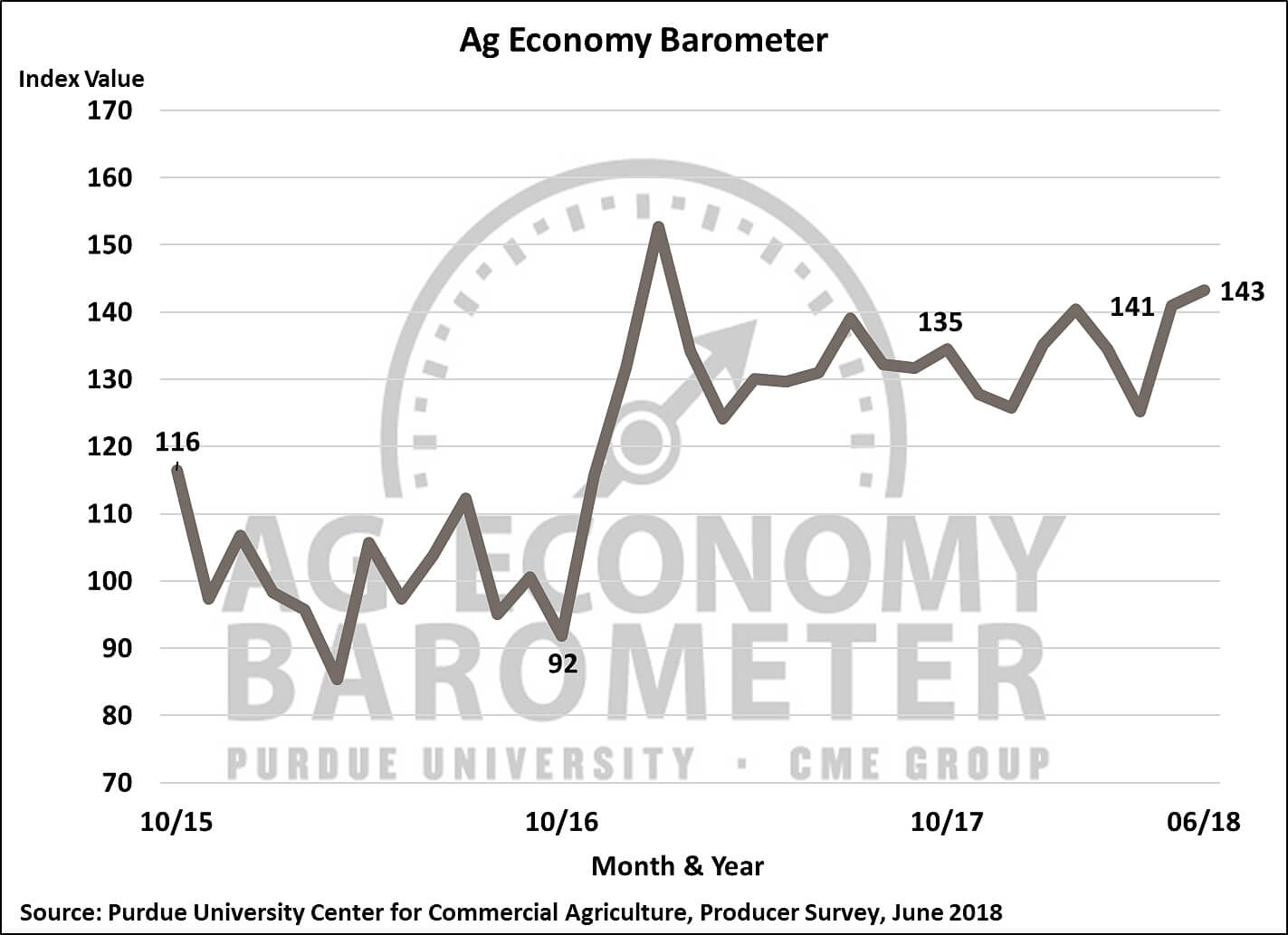Optimism drives farmer sentiment higher; producers weigh-in on farm bill and crop insurance
Agricultural producer sentiment rose last month to its highest level since January 2017, as producers expressed an improved view of current conditions and future expectations of the U.S. agricultural economy, according to the Purdue University/CME Group Ag Economy Barometer.
The May barometer reading of 141 was 16 points higher than April. The rise in the barometer, a sentiment index derived from a monthly survey of 400 agricultural producers across the U.S., was driven both by producers’ improved view of current conditions in the production agriculture sector and, especially, their more optimistic view of the future.
The Index of Current Conditions increased to 132 during May, 9 points higher than in April, while the Index of Future Expectations climbed to 145, 19 points higher than a month earlier, making it the highest future expectations reading since February 2017.
Driving that optimism was a large improvement in producers’ expectations regarding the future for both the U.S. ag economy and their own farms’ financial conditions.
“Over the last month there’s been a relaxation in international trade tensions with China, and that seems to be playing a role in how producers are viewing their financial future,” said James Mintert, the barometer’s principal investigator and director of Purdue University’s Center for Commercial Agriculture. The rise in the Index of Future Expectations was the largest one-month increase since January 2017. This was in contrast to last month’s reading when, in the midst of deteriorating trade relations, there was a decline in sentiment toward the agricultural economy as a whole and with respect to producers’ own farming operations.
Despite the improvement in sentiment, producers’ perspectives on making large investments on their farms changed very little with only 27 percent of producers saying now is a good time to make large farm investments.
Producers also weighed in on the farm bill debates taking place in Congress. When asked whether the current 2014 version of the U.S. farm bill provided producers with a financial safety net, only 25 percent of respondents said it was effective. More specifically, when asked about the current ARC-County (Agricultural Risk Coverage) and PLC (Price Loss Coverage) income support programs included in the 2014 farm bill, only one-quarter of the respondents said these programs were effective in providing a financial safety net, and nearly one-third said they were not effective.
When asked about crop insurance, an integral part of current farm bill discussions, nearly two-thirds of producers considered the crop insurance program to be effective in providing a financial safety net.
Lastly, the May survey asked what actions, if any, a producer would take if changes to the crop insurance subsidy caused insurance premiums to increase by 50 percent. More than half of producers said they would change either the insurance product they purchase or their coverage level, and just over a quarter of respondents said they would not purchase crop insurance next year if their cost increased by half.
For additional information about producer sentiment regarding Farm Bill legislation, including crop insurance and subsidies, read the full May Ag Economy Barometer report at http://purdue.edu/agbarometer.
The Ag Economy Barometer, Index of Current Conditions and Index of Future Expectations are available on the Bloomberg Terminal under the following ticker symbols: AGECBARO, AGECCURC and AGECFTEX.
About the Purdue University Center for Commercial Agriculture
The Center for Commercial Agriculture was founded in 2011 to provide professional development and educational programs for farmers. Housed within Purdue University’s Department of Agricultural Economics, the center’s faculty and staff develop and execute research and educational programs that address the different needs of managing in today’s business environment.
About CME Group
As the world’s leading and most diverse derivatives marketplace, CME Group (www.cmegroup.com) enables clients to trade futures, options, cash and OTC markets, optimize portfolios, and analyze data – empowering market participants worldwide to efficiently manage risk and capture opportunities. CME Group exchanges offer the widest range of global benchmark products across all major asset classes based on interest rates, equity indexes, foreign exchange, energy, agricultural products and metals. The company offers futures and options on futures trading through the CME Globex® platform, fixed income trading via BrokerTec and foreign exchange trading on the EBS platform. In addition, it operates one of the world’s leading central counterparty clearing providers, CME Clearing. With a range of pre- and post-trade products and services underpinning the entire lifecycle of a trade, CME Group also offers optimization and reconciliation services through TriOptima, and trade processing services through Traiana.
CME Group, the Globe logo, CME, Chicago Mercantile Exchange, Globex, and E-mini are trademarks of Chicago Mercantile Exchange Inc. CBOT and Chicago Board of Trade are trademarks of Board of Trade of the City of Chicago, Inc. NYMEX, New York Mercantile Exchange and ClearPort are trademarks of New York Mercantile Exchange, Inc. COMEX is a trademark of Commodity Exchange, Inc. BrokerTec, EBS, TriOptima, and Traiana are trademarks of BrokerTec Europe LTD, EBS Group LTD, TriOptima AB, and Traiana, Inc., respectively. Dow Jones, Dow Jones Industrial Average, S&P 500, and S&P are service and/or trademarks of Dow Jones Trademark Holdings LLC, Standard & Poor’s Financial Services LLC and S&P/Dow Jones Indices LLC, as the case may be, and have been licensed for use by Chicago Mercantile Exchange Inc. All other trademarks are the property of their respective owners.







